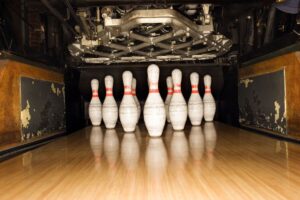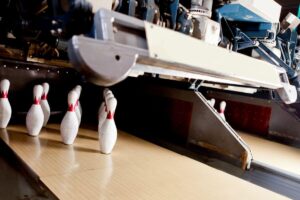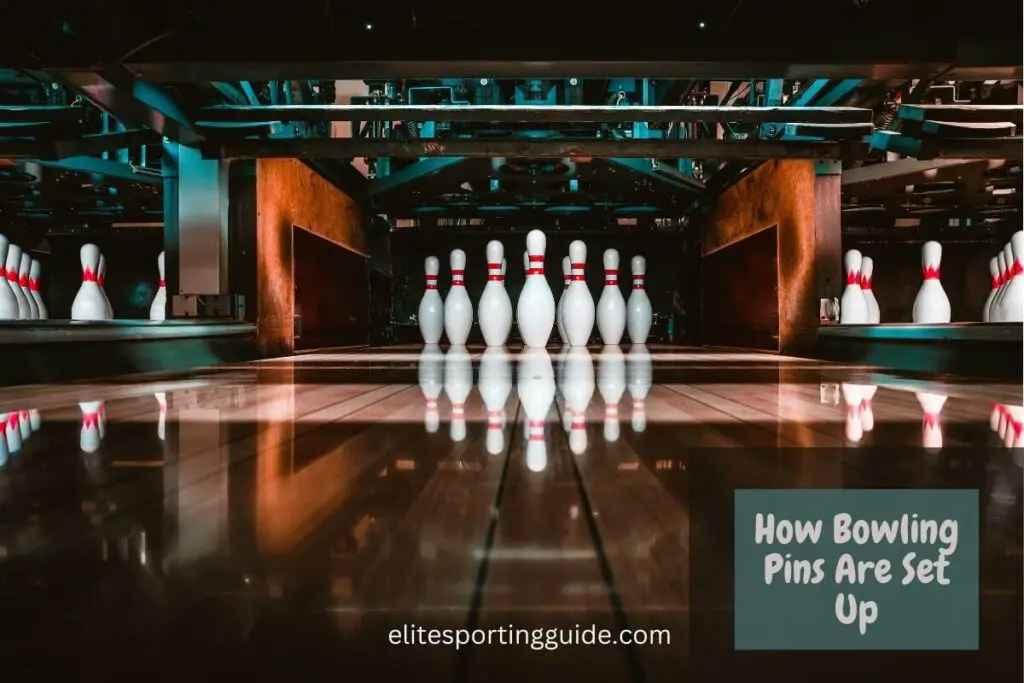When it comes to the world of bowling, there’s more than meets the eye.
Behind every successful roll and satisfying strike lies the intricately orchestrated arrangement of bowling pins.
Have you ever wondered how these pins are meticulously positioned at the start of each game?
In this article, we go behind-the-scenes to televise to you the setting up of bowling pins while unveiling the careful calculations, techniques, and equipment involved.
How Bowling Pins Are Set Up
The pins are set in a triangular formation, known as the pin deck, with a specific pattern called the “pin spot”. These bowling pins are placed in this triangular format by a machine known as the pinsetter. The pinsetter retrieves the fallen pins, clears the lane, and resets the pins for the next bowler, ensuring a consistent and efficient process throughout the game.
The Triangular Formation (10 Pin Bowling Setup)
The triangular formation is the cornerstone of bowling pin setup, providing the foundation for fair and challenging gameplay.
The 10 pins are arranged in a specific pattern on the pin deck, resembling an equilateral triangle. Each pin in the setup is numbered for identification purposes.
The head pin is numbered as pin 1, followed by pins 2 through 4 in the second row, pins 5 through 7 in the third row, and pins 8 through 10 in the back row.
This numbering system helps in scoring and communication between bowlers and officials. This arrangement ensures that the pins are evenly distributed across the lane, presenting bowlers with an equal opportunity to knock them down and score points.
The triangular formation also facilitates strategic play, as it allows bowlers to aim for specific pins and utilize angles to achieve optimal pin carry.
The geometry behind the triangular formation is a key aspect to consider.
Each row of pins in the triangle represents a different distance from the bowler, creating a gradual increase in the challenge as the bowler progresses towards the back row.
The placement of the pins within the triangle follows a precise pattern, with the front row having one pin, the second row consisting of two pins, the third row featuring three pins, and the back row comprising four pins.
This arrangement is not only aesthetically pleasing but also strategically significant, as it requires bowlers to strategically target specific pins to maximize their chances of knocking down the entire formation.
The triangular formation is not solely about aesthetics and challenge; it also influences the pin action and overall dynamics of the game.
As the bowling ball makes contact with the pins, the triangular arrangement plays a role in determining how the pins scatter and interact with each other.
The pin spacing within the triangle affects pin carry, which refers to how the knocked-down pins move and potentially knock down other pins in the process.
By understanding the intricacies of the triangular formation, bowlers can adjust their approach, angle, and speed to optimize their chances of achieving the desired pin action and maximizing their scores.
The Role Of The Pinsetter

The pinsetter is a mechanical device used in bowling alleys to clear fallen pins from the pin deck, reset them, and prepare the lane for the next frame.
It automates the process of pin setup, eliminating the need for manual pin placement and allowing for a more efficient and consistent gameplay experience.
The pinsetter consists of various components, including mechanical arms, conveyor belts, pin holders, sensors, and motors.
After a bowler delivers their shot and knocks down the pins, the pinsetter is activated. It first uses mechanical arms to clear the fallen pins from the pin deck, lifting them up and depositing them into a collection area or pin pit.
The pins are then separated and sent through conveyor belts or chutes that return them to a pin holder or storage area.
Simultaneously, the pinsetter retrieves new pins from a storage rack or pin elevator.
The pins are positioned precisely according to the triangular formation on the pin deck, guided by sensors and mechanical arms.
Once the pins are accurately set, the pinsetter ensures they are stable and ready for the next frame.
Pinsetters have evolved over the years, with various models and technologies introduced to improve efficiency, reliability, and safety.
Modern pinsetters are highly sophisticated and can handle the repetitive tasks of clearing, sorting, and resetting pins with speed and precision, allowing for uninterrupted gameplay.
The Anatomy Of The Pin Deck
The pin deck is a fundamental component of a bowling lane, where the action and excitement of knocking down pins unfold.
It is a flat, sturdy surface located at the end of the lane, designed to hold the bowling pins in place and provide a consistent playing environment.
The pin deck is typically made of wood or synthetic materials, engineered to withstand the impact of bowling balls and the movement of pins.
It features pin spots, which are precisely marked positions that guide the placement of the pins in the triangular formation.
These spots ensure uniformity and consistency across different lanes, allowing bowlers to rely on consistent pin placement during their shots.
Behind the pin deck, there is the pinsetter area, which houses the mechanical pinsetting machinery. This area is significant for efficiently clearing fallen pins, resetting them, and accurately positioning them for each frame.
The pinsetter area is equipped with mechanisms and sensors that work in coordination to perform these tasks.
Kickbacks, angled boards positioned at the back of the pin deck, deflect the bowling ball away from the pins and redirect it towards the pit area, preventing potential hazards and ensuring a smooth flow of the game.
Regular maintenance and cleaning of the pin deck are essential to preserve its integrity and provide bowlers with an optimal playing surface.
The Art of Pin Placement
Pin placement is an art form in the world of bowling, requiring a delicate balance of precision and strategy. The strategic positioning of bowling pins on the pin deck can significantly impact the difficulty and outcome of each frame.
While the triangular formation provides the basic framework, the art of pin placement involves subtle adjustments and considerations to create a challenging and fair playing field.
One key aspect of pin placement is achieving balance. The pins must be evenly distributed across the pin deck, ensuring that no particular area or side of the lane has a higher concentration of pins.
This balance prevents any undue advantage or disadvantage for bowlers and promotes consistent gameplay.
Achieving balance also extends to the spacing between pins within the triangle, allowing for proper pin action and minimizing the likelihood of pins simply sliding or toppling without affecting other pins.
Pin placement is not solely about equal distribution; it also involves strategic considerations.
The positioning of the head pin, which is the front-center pin in the triangular formation, can greatly impact pin carry and scoring potential.
Placing the head pin slightly off-center can create more challenging angles for bowlers, requiring them to carefully navigate their shots to maximize their chances of a strike or spare.
Adjusting the positioning of the other pins within the triangle can also influence pin action and create different challenges for bowlers, enhancing the strategic aspects of the game.
Furthermore, pin placement is influenced by lane conditions. Factors such as oil patterns and lane topography can affect how the ball interacts with the pins.
Bowlers and lane technicians analyze these conditions to determine the optimal placement that balances difficulty and fairness.
Adjustments may be made to the pin spacing or positioning based on the specific characteristics of the lane, allowing for a customized setup that suits the playing environment.
In essence, pin placement is an intricate blend of precision, strategy, and adaptability.
Bowling alley technicians and professionals meticulously study the lane conditions, player feedback, and the desired challenge level to create a pin placement that tests bowlers’ skills while maintaining the integrity of the game.
The art of pin placement adds depth and complexity to the sport, enhancing the overall experience for both recreational and competitive bowlers.
Related post: How Many Pins Are In Bowling?
Pin Setup Techniques

Pin setup techniques in bowling involve strategic positioning of the bowling pins to maximize the chances of knocking them down with each throw.
Bowlers employ various techniques based on factors such as lane conditions, personal style, and pin carry preferences.
One common technique is “pin triangulation,” where bowlers aim to hit the pins at specific angles to create a chain reaction, causing multiple pins to fall simultaneously.
Another technique is “pin targeting,” where bowlers aim for a specific pin in the setup, known as a “key pin,” which can lead to a higher chance of achieving strikes or spares.
Additionally, bowlers may adjust their position on the approach, modify their release, or alter their ball speed and rotation to optimize pin carry and increase their overall scoring potential.
Mastering pin setup techniques requires practice, adaptability, and a deep understanding of lane conditions and ball dynamics.
Regulations and Standards for Pin Setup
Regulations and standards for pin setup in bowling are in place to ensure consistent and fair gameplay across different bowling alleys and competitions.
Here are some key aspects of pin setup regulations:
1. Pin Placement Specifications: Bowling organizations, such as the United States Bowling Congress (USBC), set specific guidelines for pin placement.
These guidelines define the triangular formation, including the distances between pins, the positioning of the head pin, and the alignment with lane markings.
2. Pin Height and Weight: Regulations also govern the height and weight of bowling pins.
Standard pins must have a height of 15 inches (38 cm) from the base to the top, and their weight should range between 3 pounds 6 ounces (1.53 kg) to 3 pounds 10 ounces (1.64 kg).
These regulations ensure consistency and uniformity in pin performance.
3. Lane Dressing and Oil Patterns: Bowling lanes are typically coated with oil to protect the wood surface and provide a consistent playing condition.
Regulations specify the application of oil patterns on the lanes, which can affect pin carry, ball motion, and scoring.
These patterns may vary depending on the level of competition and can be adjusted to challenge bowlers of different skill levels.
4. Pinsetter Specifications: Automatic pinsetter machines used in bowling alleys must meet safety and operational standards. These standards ensure that pinsetters properly handle the pins, clear fallen pins efficiently, and reset them accurately for each frame.
5. Certification and Inspection: Bowling centers and equipment, including pins and pinsetters, undergo regular certification and inspection processes to ensure compliance with regulations.
This ensures that the playing conditions and equipment meet the required standards for fair play.
Adhering to these regulations and standards helps maintain consistency and fairness in the sport of bowling.
They create a level playing field for all participants and enable bowlers to focus on skill, strategy, and competition, knowing that the setup meets standardized guidelines.
The Evolution of Pin Setup
The evolution of pin setup in bowling has undergone significant changes throughout the history of the sport. From manual pin placement to automated pinsetters, here is a glimpse into the evolution of pin setup:
1. Manual Pin Placement: In the early days of bowling, pin setup was a manual process. Pin boys, often young individuals, would manually set up the pins by hand after each frame.
This labor-intensive method required speed, accuracy, and physical endurance.
2. Computerized Pinsetters: As technology continued to advance, computerized pinsetters became more prevalent.
These sophisticated machines utilized sensors, motors, and computer systems to automate the entire pin setup process.
They efficiently cleared the fallen pins, reset them, and precisely positioned them according to the desired configuration. Computerized pinsetters improved accuracy, reduced human error, and further expedited gameplay.
3. Modern Pinsetter Innovations: In recent years, there have been additional innovations in pinsetter technology. Enhanced pinsetter designs have improved reliability, ease of maintenance, and energy efficiency.
Some modern pinsetters incorporate features like automatic pin calibration, improved pin handling mechanisms, and enhanced pin visibility for players.
The evolution of pin setup has not only streamlined the game but also enhanced the overall bowling experience.
Automated pinsetters have significantly reduced the time between frames, allowing for a faster-paced game and increased the number of games that can be played in a given time.
These advancements have also contributed to a safer and more standardized playing environment.
As technology continues to advance, it’s possible that further innovations and improvements in pin setup will continue to emerge, ensuring that bowlers can enjoy the game with greater convenience and consistency.
Post you may be interested in: What Is Duckpin Bowling?
Tips for Home Bowling: DIY Pin Setup for Recreational Play
Tips for Home Bowling: Setting Up Pins for Recreational Play
If you’re looking to enjoy some bowling fun at home, setting up the pins properly is essential for a satisfying and realistic experience. Here are a few tips to help you achieve a DIY pin setup for recreational play:
1. Create a Triangular Formation: Mimic the professional bowling setup by arranging the pins in a triangular formation.
Use a clear, flat surface and position the pins in four rows, with the front row having one pin, the second row with two pins, the third row with three pins, and the back row with four pins.
Ensure the spacing between the pins is even to maintain fairness.
2. Secure the Pins: To prevent the pins from falling or tipping over easily, use pin holders or stands. These can be purchased online or made using sturdy materials like wood or plastic.
Simply place the pins into the holders, ensuring they are stable and won’t wobble during gameplay.
3. Consider Pin Weight: Regular bowling pins are quite heavy, so for home bowling, you can opt for lightweight alternatives that are easier to handle and less likely to damage floors or furniture.
Look for plastic or foam bowling pins designed for recreational use, which are safer and more suitable for indoor settings.
4. Lane Preparation: Clear a suitable space for your DIY bowling lane, ensuring it is long and wide enough for bowling shots. Ideally, use a smooth surface such as hardwood or a low-pile carpet to allow the ball to roll smoothly. Ensure there are no obstacles or breakable items nearby.
5. Enjoy Safety Measures: Safety should always be a priority. Make sure there is enough room for players to safely throw the ball without any obstructions. Consider using a designated bowling mat or area to mark the spot where players should stand during their turns.
With these tips, you can create an enjoyable home bowling experience with a DIY pin setup.
Gather your friends and family, set up the pins, and have a great time practicing your bowling skills or engaging in friendly competitions right at home.



